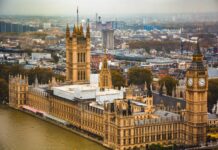Tackling heat in buildings: five policies affecting business and the public sector
News coverage of the UK government’s long-delayed Heat and Buildings Strategy has focused on how it will affect domestic heating, but the government also has significant plans to decarbonise our public, commercial and industrial buildings.
Here are five policy developments for non-domestic buildings that you may have missed.
Fabric-first approach: don’t delay on efficiency measures
The government’s journey to net zero buildings starts with the efficiency of the buildings themselves, the so-called “fabric-first” approach. This means minimising energy wastage and unnecessary heat loss before looking at upgrades to the heating system. But this isn’t just about the building itself, but also about how it is used, and this poses a problem when trying to evaluate energy use for large non-domestic buildings with complex operations.
The government recently consulted on introducing a new mandatory energy performance rating framework for large commercial and industrial buildings, as promised in September 2020’s Energy Performance Certificate Action Plan. The use of such performance-based schemes has been tried in other countries and proved to be very successful in motivating businesses to cut emissions. Phase 1 of the scheme will start in April 2022, but businesses would be well advised to tackle the “low-hanging fruit” of efficiency measures far in advance of this.
2. Heat network zoning for some large commercial and industrial buildings
The Climate Change Committee has said that 18% of the UK’s heat supply should come from heat networks by 2050, but this figure currently stands at just 3%, despite the work of the
Heat Networks Investment Project. A bigger push from above is needed, which is why the government plans to give local authorities the power to designate areas as heat network zones. Certain buildings within these zones would be required to connect to the heat network within a given timeframe, including large public sector buildings and large non-domestic buildings. The strategy states that large commercial and industrial buildings are among those best equipped to transition to heat networks in the 2020s.
3. Public sector buildings to lead the way
Public sector buildings account for 9% of all buildings emissions in the UK, and the Heat and Buildings Strategy acknowledges that it is important to “lead by example”. This is why the government launched the Public Sector Decarbonisation Scheme in September 2020, with a plan to halve public sector emissions by 2032.
The updated plan, as set out in the Heat and Buildings Strategy and the newly published Net Zero Strategy, is to build on this ambition and cut emissions by 75% before 2037. This means taking 11 years to halve emissions from their current level and then a further five years to halve them again. This will be tricky because of the diverse nature of public buildings and their heating needs, but further funding will help organisations with both energy efficiency measures and heating technology upgrades. The Public Sector Decarbonisation Scheme had £75 million allocated for 2021/22 and will spend a further £1425 million up to 2024/5.
4. Don’t bank on greener gas
The Heat and Buildings Strategy describes existing research into the use of both hydrogen and biomethane as greener alternatives to natural gas in the grid. However, it is far from clear what role hydrogen can actually play – which is why the government is doing so much research, as set out in the Hydrogen Strategy. It will not make any decisions about the role of hydrogen in heating until at least 2026. As for biomethane, there simply isn’t enough of it for it to be a valid replacement for natural gas; it makes up less than 1% of gas in the grid and this seems unlikely to change.
The Climate Change Committee has long said that we need extensive electrification of the UK’s heating systems if we are to reach our net zero target, and this is why the Heat and Buildings Strategy focuses so much on heat pumps and heat networks. Businesses should take this into account when developing their own net zero strategy.
5. A shake-up of the extras on your fuel bills
Non-commodity costs make up a surprisingly high proportion of energy bills for businesses. These are charges separate to the energy itself, and include government green levies to accelerate the decarbonisation of the grid.
The government is now planning to redesign these costs to incentivise businesses and homes to electrify, by making electricity cheap and gas more expensive.
It is not yet clear exactly how the new system will work, but businesses should now be aware that the economic case for which heating fuel to choose will change as a result. The government will be launching a Call for Evidence soon and making a decision in 2022.













